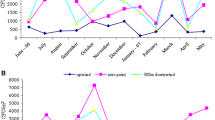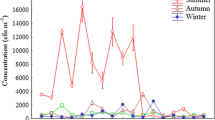Abstract
In this study, the effect of the thermophilic fungi of composts was analysed on the fungal composition of the air above. Air samples were collected with an Andersen air sampler at 1.5 m height in three large industrial composting facilities treating different waste types. Repetition was collected on three calm and rain-free days of three consecutive weeks in October 2011, in January, April and July 2012; five plates were exposed successively per sampling day. Compost samples were also collected (averaging 1 kg/compost piles). Air and compost samples were cultured at 50 °C. The thermophilic fungal composition of the air near the compost piles of different waste types differed significantly (p < 0.05) from that of the control site above a grassland ecosystem at each sampling time. Seasonal differences could be detected regarding the total number of thermophilic fungi in the air near the agricultural and horticultural compost types, but smaller differences were found near the municipal compost type. A total of 13 and 11 fungal species were detected in the compost and air samples where the dominant species were Thermomyces lanuginosus and Rasamsonia emersonii, respectively. The concentration of airborne thermophilic fungi was higher near the horticultural compost type and lower near the municipal compost. The results suggest that the differences between the incidences of some species in composts and associated aerosols refer to spore ontogeny and biological mechanisms of spore liberation.


Similar content being viewed by others
References
Anastasi, A., Varese, G. C., & Marchisio, V. F. (2005). Isolation and identification of fungal communities in compost and vermicompost. Mycologia, 97(1), 33–44.
Andersen, A. A. (1958). New sampler for the collection, sizing, and enumeration of viable airborne particles. Journal of Bacteriology, 76, 471–484.
Azad, K., Hossain, F., & Halim, M. A. (2013). Screening of cellulase, pectinase and xylanase activities and optimization of radial mycelial growth of two thermophilic fungi. Bangladesh Journal of Botany, 42(2), 207–213.
Bellemain, E., Carlsen, T., Brochmann, C., Coissac, E., Taberlet, P., & Kauserud, H. (2010). ITS as an environmental DNA barcode for fungi: An in silico approach reveals potential PCR biases. BMC Microbiology, 10, 189. doi:10.1186/1471-2180-10-189.
Breitenbach, M., Crameri, R., & Lehrer, S. B. (Eds.). (2002). Fungal allergy and pathogenicity. Basel: Karger.
Bru-Adan, V., Wéry, N., Moletta-Denat, M., Boiron, P., Delgenes, J. P., & Godon, J. J. (2009). Diversity of bacteria and fungi in aerosols during screening in a green waste composting plant. Current Microbiology, 59, 326–335. doi:10.1007/s00284-009-9438-3.
Cole, G. T., & Samson, R. A. (1979). Patterns of development in conidial fungi. London: Pitman.
Cooney, D. G., & Emerson, R. (1964). Thermophilic fungi: An account of their biology, activities, and classification. San Francisco: W. H. Freeman and Co.
Cox, C. S. (1987). The aerobiological pathway of microorganisms. New York: Wiley Interscience.
Crisan, E. V. (1964). Isolation and culture of thermophilic fungi. Contributions from Boyce Thompson Institute of Plant Research, 22, 291–301.
Evans, H. C. (1972). Thermophilous fungi isolated from the air. Transactions of the British Mycological Society, 59, 516–519.
Farina, C., Gamba, A., Tambini, R., Beguin, H., & Trouillet, J. L. (1998). Fatal aortic Myceliophthora thermophila infection in a patient affected by cystic medial necrosis. Medical Mycology, 36(2), 113–118.
Feller, W. (1950). An introduction to the probability theory and its application. New York: Wiley.
Fischer, G., Muller, T., Ostrowski, R., & Dott, W. (1999). Mycotoxins of Aspergillus fumigatus in pure culture and in native bioaerosols from compost facilities. Chemosphere, 38, 1745–1755.
Gregory, P. H. (1973). The microbiology of the atmosphere. Aylesbury, Bucks: Leonard Hill Books.
Grinn-Gofroń, A., & Strzelczak, A. (2013). Changes in concentration of Alternaria and Cladosporium spores during summer storms. International Journal of Biometeorology, 57, 759–768.
Hadaschik, E., Koschny, R., Willinger, B., Hallscheidt, P., Enk, A., & Hartschuh, W. (2012). Pulmonary, rhino-orbital and cutaneous mucormycosis caused by Rhizomucor pusillus in an immunocompromised patient. Clinical Experimental Dermatology, 37(4), 355–357. doi:10.1111/j.1365-2230.2011.04235.x.
Hryhorczuk, D., Curtis, L., Scheff, P., Chung, J., Rizzo, M., Lewis, C., et al. (2001). Bioaerosol emissions from a suburban yard waste composting facility. Annals of Agricultural and Environmental Medicine, 8, 177–185.
Ingold, C. T. (1971). Fungal spores, their liberation and dispersal. Oxford: Clarendon Press.
Jones, A. M., & Harrison, R. M. (2004). The effects of meteorological factors on atmospheric bioaerosol concentrations—a review. The Science of the Total Environment, 326, 151–180.
Kampfer, P., Jureit, C., Albrecht, A., & Neef, A. (2002). Imission of microorganisms from composting facilities. In S. Klammer (Ed.), Microbiology of composting (pp. 571–584). Berlin: Springer.
Kimura, M., Udagawa, S., Makimura, K., Satoh, K., Toyazaki, N., & Ito, H. (2009). Isolation and identification of Rhizomucor pusillus from pleural zygomycosis an immunocompetent patient. Medical Mycology, 47(8), 869–873. doi:10.3109/13693780903059485.
Lacey, J. (1975). Airborne spores in pastures. Transactions of the British Mycological Society, 64(2), 265–281. doi:10.1016/S0007-1536(75)80112-4.
Lacey, J. (1979). Aerial dispersal and the development of microbial communities. In J. M. Lynch & N. J. Poole (Eds.), Microbial ecology (pp. 140–170). Oxford: Blackwell.
Lacey, M. E., & West, J. S. (2006). The air spora. A manual for catching and identifying airborne biological particles. Dordrecht: Springer.
Langarica-Fuentes, A., Handley, P. S., Houlden, A., Fox, G., & Robson, G. D. (2014). An investigation of the biodiversity of thermophilic and thermotolerant fungal species in composts using culture-based and molecular techniques. Fungal Ecology, 11, 132–144. doi:10.1016/j.funeco.2014.05.007.
LeGoff, O., Bru-Adan, V., Bacheley, H., Godon, J. J., & Wery, N. (2010). The microbial signature of aerosols produced during the thermophilic phase of composting. Journal of Applied Microbiology, 108, 325–340. doi:10.1111/j.1365-2672.2009.04427.x.
Li, A. N., Yu, K., Liu, H. Q., Zhang, J., Li, H., & Li, D. C. (2010). Two novel thermostable chitinase genes from thermophilic fungi: Cloning, expression and characterization. Bioresource Technology, 101(14), 5546–5551. doi:10.1016/j.biortech.2010.02.058.
Magyar, D. (2007). Aeromycological aspects of mycotechnology. In M. K. Rai (Ed.), Mycotechnology: Current trends and future prospects (pp. 226–263). New Delhi: I.K. International Publishing House.
Martin, J. P. (1950). Use of acid, rose bengal, and streptomycin in the plate method for estimating soil fungi. Soil Science, 69, 215–232.
McClendon, S. D., Batth, T., Petzold, C. J., Adams, P. D., Simmons, B. A., & Singer, S. W. (2012). Thermoascus aurantiacus is a promising source of enzymes for biomass deconstruction under thermophilic conditions. Biotechnology for Biofuels, 5, 54. doi:10.1186/1754-6834-5-54.
Millner, P. D., Bassett, D. A., & Marsh, P. B. (1980). Dispersal of Aspergillus fumigatus from sewage sludge compost piles subjected to mechanical agitation in open air. Applied and Environmental Microbiology, 39, 1000–1009.
Morgenstern, I., Powlowski, J., Ishmael, N., Darmond, C., Marqueteau, S., Moisan, M. C., et al. (2012). A molecular phylogeny of thermophilic fungi. Fungal Biology, 116(4), 489–502.
Morio, F., Fraissinet, F., Gastinne, T., Le Pape, P., Delaunay, J., Sigler, L., et al. (2011). Invasive M. thermophila infection mimicking invasive aspergillosis in a neutropenic patient: A new cause of cross-reactivity with the Aspergillus galactomannan serum antigen assay. Medical Mycology, 49(8), 883–886.
Mouchacca, J. (1997). Thermophilic fungi: Biodiversity and taxonomic status. Cryptogamie Mycologie, 18, 19–69.
Mouchacca, J. (2000). Thermophilic fungi and applied research: A synopsis of name changes and synonymies. World Journal of Microbiology & Biotechnology, 16, 881–888.
Pyrri, I., & Kapsanaki-Gotsi, E. (2007). A comparative study on the airborne fungi in Athens, Greece, by viable and non-viable sampling methods. Aerobiologia, 23, 3–15.
Reiss, E., Shadomy, H. J., & Lyon, G. M. (2011). Fundamental medical mycology. Hoboken, NJ: Wiley-Blackwell.
Ryckeboer, J., Mergaert, J., Vaes, K., Klammer, S., De Clercq, D., Coosemans, J., et al. (2003). A survey of bacteria and fungi occurring during composting and self-heating processes. Annals of Microbiology, 53, 349–410.
Salar, R. K., & Aneja, K. R. (2007). Significance of thermophilic fungi in mushroom compost preparation: Effect on growth and yield of Agaricus bisporus (Lange) Sing. Journal of Agricultural Technology, 3(2), 241–253.
Sandhu, D. K., & Singh, S. (1985). Airborne thermophilous fungi at Amritsar, India. Transactions of the British Mycological Society, 84(1), 41–45.
Shannon, C. E., & Weaver, W. (1963). The mathematical theory of communication. Urbana: University of Illinois Press.
Simpson, E. H. (1949). Measurement of diversity. Nature, 163, 688.
Taha, M. P. M., Drew, G. H., Tamer, A., Hewings, G., Jordinson, G. M., Longhurst, P. J., & Pollard, S. J. T. (2007). Improving bioaerosol exposure assessments of composting facilities—comparative modelling of emissions from different compost ages and processing activities. Atmospheric Environment, 41(21), 4504–4519.
Thakur, S. B. (1977). Occurence of spores of thermophilic fungi in the air at Bombay. Mycologia, 69, 197–199.
Tilak, S. T., & Pande, B. N. (2005). Current trends in aeromycological research. In M. K. Rai & S. K. Deshmukh (Eds.), Fungi: Diversity and biotechnology (pp. 281–510). Jogpur: Scientific Publishers.
Vestlund, A. T., Al-Ashaab, R., Tyrrel, S. F., Longhurst, P. J., Pollard, S. J. T., & Drew, G. H. (2014). Morphological classification of bioaerosols from composting using scanning electron microscopy. Waste Management, 34, 1101–1108.
Wéry, N. (2014). Bioaerosols from composting facilities—a review. Frontiers in Cellular and Infection Microbiology, 4. doi:10.3389/fcimb.2014.00042.
White, T. J., Bruns, T., Lee, S., & Taylor, J. (1990). Amplification and direct sequencing of fungal ribosomal RNA genes for phylogenetics. In M. A. Innis, D. H. Gelfand, J. J. Sninsky, & T. J. White (Eds.), PCR protocols: A guide to methods and applications (pp. 315–322). New York: Academic Press Inc.
Acknowledgments
This work was supported by Grant Research Centre of Excellence-8526-5/2014/TUDPOL. We thank Brigitta Edőcs for her excellent technical assistance, and Zoltán Nagy for his help in the correction of the English text.
Author information
Authors and Affiliations
Corresponding author
Rights and permissions
About this article
Cite this article
Sebők, F., Dobolyi, C., Bobvos, J. et al. Thermophilic fungi in air samples in surroundings of compost piles of municipal, agricultural and horticultural origin. Aerobiologia 32, 255–263 (2016). https://doi.org/10.1007/s10453-015-9396-0
Received:
Accepted:
Published:
Issue Date:
DOI: https://doi.org/10.1007/s10453-015-9396-0




